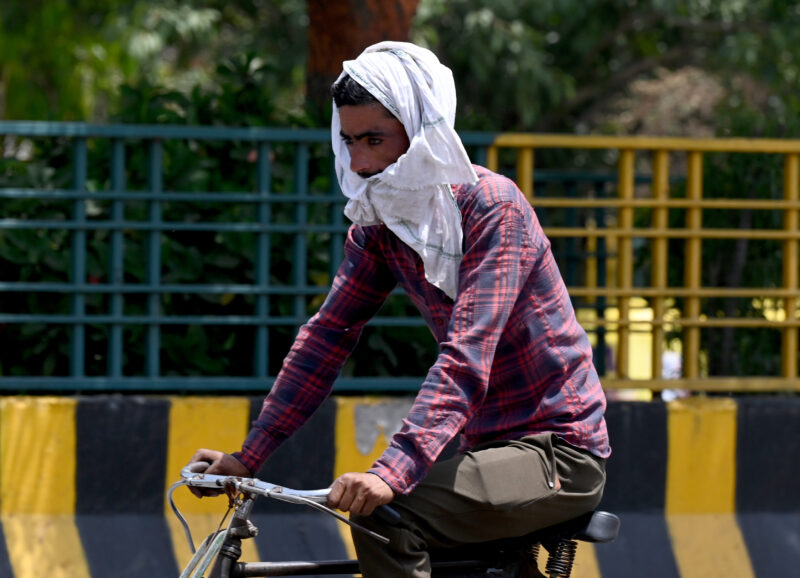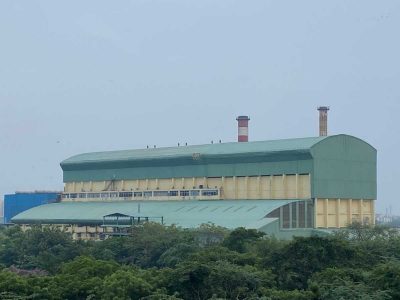Ram Kumar, a 55-year-old, spends his days installing and repairing steel structures every day. Kumar is one of the labourers who have come from far-flung villages to urban cities in search of work and has found that standing at labour chowks — unofficial labour hubs in various markets and localities of Delhi — helps him find work more often than not. But the scorching summer heat gets unbearable.
Parts of Delhi recorded heatwave conditions — with temperature rising to as high as 46.2 degrees Celsius — on May 22.
“I came to Delhi in search of work from a village in Uttar Pradesh two years ago. Since then, I have been living here with my family. Life in a village is different from life in urban cities, and I have learnt to adjust accordingly. I am not able to deal with the rising temperatures here, which is a problem for me as I have to work at a construction site, which is an open space. Most of the time, it is hard to find a spot of shade where I can get some relief from the scorching sun”, Kumar told Patriot.
Also read: Delhi too hot for animals
Kumar’s worry is shared by other semi-skilled workers and labourers who wait at labour chowks, waiting and hoping to be hired for work.
They engage in conversations, sharing their struggles. With anxious looks and perspiring bodies, some of them wipe their faces with wet cloth, trying to keep themselves cool while finding space under the shade.
Not only are these semi-skilled workers and labourers worried about whether they will earn or not on a given day as their earnings depend on daily work, they fear managing workload during the heat-wave. They can be seen sweating profusely as the summer has set in and the heat has become unbearable.
The Only Option
But Kumar says he has no other option. “My whole livelihood depends on daily wages. If I stop working, then my family will die of hunger. So, I have no other option as this is my only source of income,” he says.
Over the years, temperature in Delhi-NCR has risen to an extent where it has become hard to work in open spaces, especially for semiskilled workers, labourers, street vendors and cart-pushers since they are directly exposed to the harsh heat which can result in various chronic diseases and sudden death.

In developing countries like India, the temperature is rising continuously. If it continues to do so, it will be impossible for humans to survive in harsh heat.
According to data from the World Bank, India’s average annual temperature has increased at a rate of 0.62 °C per 100 years between 1901 and 2020 and maximum temperature has climbed at a rate of 0.99 °C every 100 years.
Worker’s, consequently, are complaining that it is hard to work in harsh sunlight but they are left with no option.
Manohar Lal, a 57-year-old mason, is worried about his deteriorating health due to the unrelenting heat-wave.
“As I am getting old, my health is getting affected due to the heat. Once, I was working at a construction site, I started suffocating and felt exhausted. Within a few seconds, I fainted and was taken to a hospital for treatment where I was told that I had suffered from heat-stroke. What can I do now and where will I go and find a new job which is suitable for me. Who will give me a job at this age?” he asks.
“We labourers have no other option as we are not educated e n o u g h t o l o o k f o r o t h e r opportunities. Our survival depends on the skills we have. If anything happens to us, then our families will suffer. But we cannot control the rising temperature as it is not in our hands.”
According to a rapid attribution study by climate scientists released in 2022, extreme heat has gripped large parts of India and chances of it rising further are 30 times more likely because of climate change.
Many labourers are exploring various ways to overcome the heatwave: some either pour a mug of water over themselves to avoid sweating and exhaustion, while others have made makeshift tents as their safeguard.
Dilip Singh, a 68-year-old street vendor who has come to Delhi from Punjab, is also struggling to work.
“I have to come from afar to install my mini-shop every day and it is very hard to travel up and down daily in the harsh sunlight. With little protection from the sun, I use this green plastic tarpaulin to deal with it. I spread it over my head and cart so that I can manage to stand in excessive humidity and heat.”
“But by the end of the day, I still suffer from fatigue, headache and fever. l have to travel back and feed my family. This heat is killing me inside and doctors have told me to leave my work but then thoughts of my family strike my mind and I convince myself that I cannot lose hope as I have a family to feed back home,” he says further.
The underprivileged and the marginalised suffer the most, and the daily wage labourers are from among them. As the heatwave continues in Delhi, it is too hot to work. Wages are lost, pushing families into poverty. Many of the labourers say that they are looking for jobs where they can stay indoors and the heat does not affect their health.
Experts claim that this heat wave is not good for health as it comes with exhaustion and can cause harmful and chronic diseases like skin cancer and more. Also, these labourers are exposed to too much dust as well, making their life more miserable and vulnerable.
Many of the labourers also complain of high blood pressure and dehydration which is also harmful for their health. With no option left, they work under pressure even while being unwell.





